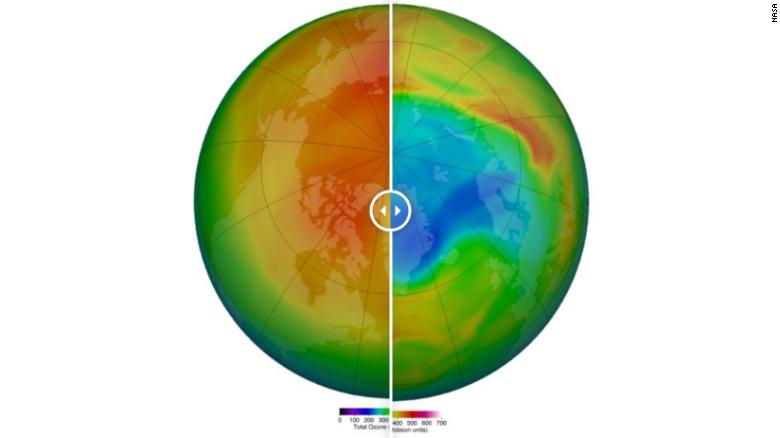- Click to share on Facebook (Opens in a new window)
- Click to share on Twitter (Opens in a new window)
- Click to share on LinkedIn (Opens in a new window)
- Click to email a friend (Opens in a new window)
Hole in ozone layer would be bigger than ever 1:09
(CNN) - The Arctic ozone layer developed a rip, which became a hole, and then a larger hole. Now, it may be the largest hole ever seen in the North Pole ozone layer.
This hole in the Arctic ozone layer has reached an area of more than 998,000 square km since it was first seen in February, Diego Loyola, a scientist at the German Aerospace Center, said in a statement to the European Space Agency.
Ozone levels in the area have dropped sharply since then.
That is unusual for some reasons. While holes in the ozone layer are reported each year in Antarctica, where temperatures are much colder, there have been no significant holes in the Arctic ozone layer since 2011.
Total ozone at the North Pole between April 2019 and April 2020: the purple and blue areas are those with the least ozone, while the yellow and red areas have the most ozone.
Even researchers at the Copernicus Program, the European Union's Earth observation program, who first saw the hole, say they are not sure why it is so large.
"In this layer, ozone is almost completely depleted," said Vincent-Henri Peuch, director of the Copernicus Atmospheric Monitoring Service.
About the ozone layer and ozone holes
Life on Earth depends on the ozone layer, which is located in the stratosphere between 14 and 35 km above Earth, to protect us from ultraviolet radiation, which is known to cause skin cancer and suppress the immune system. But man-made chemicals have been making holes for years: There has been a hole in the Antarctic ozone layer every year since 1985, when the British Antarctic Survey first reported.
There are some necessary conditions to make a hole in the ozone layer. These include chlorofluorocarbons (CFCs), manufactured chemicals that have been phased out of consumer products after they were banned in 1996, and halons, previously found in fire extinguishers, which accumulate in the atmosphere after they are emitted during human activity.
These chemicals can remain in the atmosphere for 50 to 100 years. Due to its longevity, the ozone layer is not expected to fully cure until the end of the 21st century, according to the Environmental Protection Agency (EPA)
READ : The hole in the ozone layer "will heal completely in 50 years" (2018)
How ozone holes are formed
When Antarctica is shrouded in sub-zero darkness, polar vortices can form, which are eddies of stratospheric clouds that facilitate reactions between CFCs and the ozone layer (holes usually form when the weather is -42.4 Celsius degrees).
When conditions are right and the first sunlight comes after winter, ozone breaks the CFC bond to release a chlorine atom, which can make a hole in the ozone layer, according to NASA Ozone Watch.
It is much rarer for ozone holes to form in the Arctic, where mountainous terrain at high altitudes makes it difficult for polar vortices to form and maintain their power, Peuch said.
But the existence of this record hole means that conditions must have been correct in the Arctic. However, Peuch said it is still unclear why this hole was formed.
What does the record hole mean?
The ozone level fell sharply in the affected area during February and March, Peuch said.
As a result, the UV radiation that has reached the Earth's surface is slightly higher than usual. But because the hole occurred in the winter in early spring, the UV Index peaked at 5, which is unusually high for this region but quite normal for much of the United States, which hovers around an index of 5 or 6, based on EPA monthly UV averages.
This hole does not pose much of a problem to humans, Peuch said. Because UV radiation is mainly affecting northern Greenland, which he says is sparsely populated, and the exposure won't last long, the effects of this ozone hole are minor.
Something that is concerning, he said, is how this could affect ecosystems in the area. "I can't say that, but for human health, it's quite moderate," he said.
And the hole isn't permanent either: Peuch said he expects it to start closing next week.
CNN's Brandon Miller contributed to this report.
Ozone layer






/cloudfront-eu-central-1.images.arcpublishing.com/prisa/2C5HI6YHNFHDLJSBNWHOIAS2AE.jpeg)



